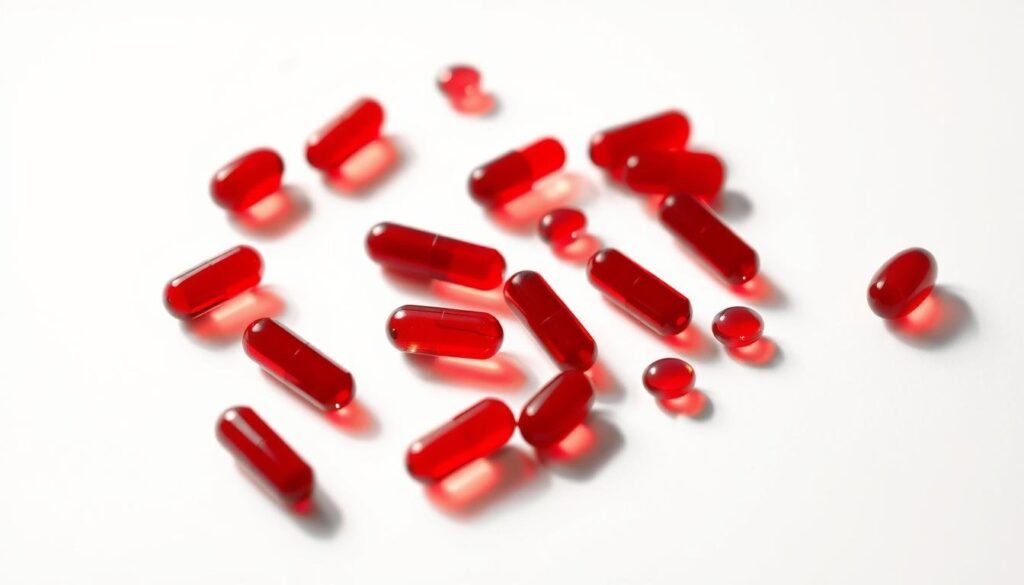Have you ever wondered about the safety of certain food colorings? The debate over artificial food dyes has grown worldwide. People are concerned about their health effects.
Rules on these colorings change a lot from place to place. Knowing the red dye regulations in Europe and the U.S. helps you choose better food.
Some countries ban these dyes because of health worries. Others are more relaxed. Looking into why this is and what it means for us can clear up the confusion.
Contents
- 1 The Current Status of Red Dye in Europe
- 2 Understanding Food Colorants: Natural vs. Synthetic Red Dyes
- 3 Is Red Dye Banned in Europe? The Complete Regulatory Picture
- 4 Spotlight on Controversial Red Dyes
- 5 Red Dye Regulations: Europe vs. United States
- 6 Health Concerns Associated with Red Food Dyes
- 7 Conclusion: Making Informed Choices About Red Dye
- 8 FAQ
- 8.1 Is red dye banned in all European countries?
- 8.2 What is the difference between natural and synthetic red dyes?
- 8.3 How do red dye regulations differ between Europe and the United States?
- 8.4 Are there health concerns associated with consuming red food dyes?
- 8.5 How can I make informed choices about red dye in my diet?
- 8.6 What role does the European Food Safety Authority (EFSA) play in regulating red dyes?
- 8.7 Can I find red dye in foods that are labeled as "natural" or "organic"?
The Current Status of Red Dye in Europe
To understand red dye in Europe, we must look at the strict food safety rules. The European Food Safety Authority (EFSA) checks the safety of food additives, like red dyes. They use the latest science to keep consumers safe.
Some synthetic red dyes face special rules in Europe because of health worries. For example:
- Red dye No. 40 is allowed but with some limits.
- Some countries have stricter rules on certain dyes.
The EFSA keeps an eye on these additives. Knowing these rules helps you choose safer food.
European food laws aim to keep us healthy. By knowing these rules, you can make better choices about food. The EFSA’s work is key in making sure food is safe for us.
Understanding Food Colorants: Natural vs. Synthetic Red Dyes
Red dyes in food can be natural or synthetic. Each has its own good and bad points. Natural dyes come from plants, animals, or minerals. Synthetic dyes are made by humans.
The debate is about their safety, how well they work, and if people like them. Synthetic dyes are often brighter and more consistent. But, they might not be as safe for our health.
Natural dyes are seen as safer but can cost more and change color over time. Beet juice is a natural red dye used in some foods. Red Dye 40 is a synthetic dye often found in the U.S.
When picking between natural and synthetic dyes, think about what matters most to you. If you want more natural ingredients, choose natural dyes. But, if you like bright colors, synthetic dyes might be better.
Knowing the difference between natural and synthetic dyes helps you make better choices. As a consumer, knowing what’s in your food can affect your health and what you buy.
Is Red Dye Banned in Europe? The Complete Regulatory Picture
Many people ask if red dye is banned in Europe. The answer depends on understanding European rules. The European Food Safety Authority (EFSA) checks the safety of food additives, like red dyes.
European rules are complex. Some synthetic red dyes are banned or limited for health reasons. But, others are still okay. For example, some red dyes in food follow specific rules.
- Safe red dyes are allowed in small amounts.
- Dyes that might be harmful are either limited or banned.
- The EFSA keeps reviewing new evidence to update rules.
Knowing these rules helps you read food labels better. It’s key to understand the differences between European and other countries’ rules, like the U.S. This shows why knowing global rules is important.
By staying up-to-date, you can choose foods that fit your health goals. The EFSA’s work means any changes in red dye rules are quickly shared. This gives you the latest info.
Spotlight on Controversial Red Dyes
Some red dyes have been linked to health issues, making us question their safety. You might have heard they can cause hyperactivity in kids or allergic reactions. This section will dive into the details of these dyes, looking at the evidence and how they are regulated.
The debate often focuses on synthetic red dyes like Red 40 and Red 3. These dyes are found in many foods and cosmetics. Here are some important points:
- Red 40 is a top food dye in the United States.
- Some studies link Red 40 to hyperactivity in children.
- Red 3 has been linked to thyroid tumors in animal studies.
Knowing about these additives can help you choose healthier foods. When you read food labels, being aware of these dyes can guide you to better choices.
Red Dye Regulations: Europe vs. United States
Europe and the US have different rules for red dye. This affects the food industry and what we choose to eat. The European Union is more careful, banning some red dyes allowed in the US.
The EU only allows a few red dyes, focusing on natural ones. In contrast, the US lets more synthetic dyes, some of which might be unhealthy.
| Regulatory Aspect | Europe | United States |
|---|---|---|
| Approved Red Dyes | Limited list, emphasis on natural colorants | Broader range, includes synthetic dyes |
| Red Dye 40 (Allura Red AC) | Restricted in certain products | Widely permitted |
| Labeling Requirements | Mandatory warning labels for certain dyes | No mandatory warning labels |
Knowing these differences is key for those who travel or are into global food trade. It helps you make better choices about what you eat. Being informed about food additives is important.
Health Concerns Associated with Red Food Dyes
Red food dyes have raised health concerns. Research shows they can cause various health issues. It’s important for consumers to know the risks.
Children and ADHD Concerns
There’s a big debate about red food dyes and Attention Deficit Hyperactivity Disorder (ADHD) in kids. Studies suggest these dyes can make hyperactivity worse. For example, a study in the Journal of Attention Disorders found a link between artificial coloring and more hyperactivity in children.
Allergy and Sensitivity Reactions
Red food dyes are also linked to allergic reactions and sensitivities. Some people may get mild skin rashes or severe reactions. The exact number of people affected is still being studied, but it’s good to know the risks.

Knowing about these health concerns helps you make better food choices. Always check labels for artificial red dyes. Try to choose natural options when you can.
Conclusion: Making Informed Choices About Red Dye
Knowing about red dye and its rules helps you choose better. It’s important to understand the difference between natural and synthetic dyes. Also, knowing about health risks and how rules change in Europe and the US is key.
Your choices matter a lot. By picking products with natural red dyes, you help make the food industry healthier. Staying informed lets you make choices that fit your health goals and tastes, keeping red dye safe.
It’s vital to know what you’re eating. Being aware of ingredients and rules helps you make better choices. This way, you can enjoy tasty foods that are also safe for you.
FAQ
Is red dye banned in all European countries?
Some synthetic red dyes are banned or restricted in Europe. But, not all red dyes are off-limits.
What is the difference between natural and synthetic red dyes?
Natural red dyes come from plants, animals, or minerals. Synthetic dyes are made by humans. Synthetic dyes are brighter and more consistent but raise health concerns.
How do red dye regulations differ between Europe and the United States?
Europe is more cautious, banning or limiting certain dyes still allowed in the US. The European Food Safety Authority (EFSA) regularly checks these additives’ safety.
Are there health concerns associated with consuming red food dyes?
Studies suggest red food dyes might cause hyperactivity in kids and allergic reactions.
How can I make informed choices about red dye in my diet?
Knowing the difference between natural and synthetic dyes is key. Be aware of health risks and understand how rules vary between Europe and the US. This helps you make better choices about food additives.
What role does the European Food Safety Authority (EFSA) play in regulating red dyes?
The EFSA checks the safety of food additives, like red dyes, based on new science. Rules can change with new evidence.
Can I find red dye in foods that are labeled as "natural" or "organic"?
Foods labeled as “natural” or “organic” might have less synthetic red dye. But, always check the ingredient list to be sure.

Marcellus Stark is an investigative journalist from San Francisco, USA. He writes about global bans, rules, and unusual laws. He shares clear, interesting, and well-researched stories that help readers understand surprising facts worldwide.

